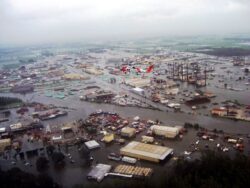Hurricane Ike
Hurricane Ike’s size and timing was a sobering reminder that Louisiana was underprepared for another storm on the scale of Hurricane Katrina.

United States Coast Guard
Hurricane Ike damage.
On Thursday, September 11, 2008, just days after Hurricane Gustav struck Louisiana, the National Hurricane Center issued another tropical storm warning extending from the mouth of the Mississippi River to Cameron Parish, and a hurricane watch from Cameron Parish to Brownsville, Texas. With many residents still displaced from Gustav or fighting for assistance, the front page of the New Orleans Times-Picayune reflected on the fiasco that could ensue if another storm hit. Articles warned of offline utilities, disaster food stamp and assistance delays, and water level rises in lakes and rivers that had yet to recede. In short, another hit, whether direct or not, would be catastrophic, much like the set of storms three years earlier, Hurricanes Katrina and Rita.
As the storm continued to develop the next day, heading more westward toward a direct hit on the Galveston area before curving towards Houston, Louisianans in low-lying and coastal areas evacuated, despite having done so just the week before. Nearly one million Texas residents also evacuated, many heading to New Orleans, where Mayor Ray Nagin reciprocated the invitation given to New Orleanians for Gustav. The city of Houston was notably absent as part of the evacuation process, though. Residents there were told to shelter in place to avoid a catastrophic evacuation process like the botched one for Hurricane Rita, which led to the death of 110, more fatalities than the storm caused.
By the end of the day, storm surge was already felt along the Louisiana-Texas coast. The six-hundred-mile-wide massive Category 4 storm brought with it abundant storm surge, which quickly swallowed the Venetian Isles, a small group of raised homes between Lake Pontchartrain and Lake Borgne in Orleans Parish. Over the next two days, the hurricane followed a path similar to Hurricane Rita, hitting western Louisiana and eastern Texas with storm surge, tornadoes, and devastating flooding.
Despite the storm’s intensity, it had weakened to a Category 2 by the time it made landfall in Galveston, but, unfortunately, it had not lost much of its width. Ike struck a vast swath of already weakened coastal marshes, and consequently, tidal surges along much of the Louisiana coast were roughly two feet higher than they had been during Hurricane Rita. In the hardest-hit area of Louisiana, Cameron Parish, nearly every inch of coastal land flooded, reaching nearly 30 miles inland to Lake Charles. Meanwhile, floodwaters on the Texas side of the storm drowned three-quarters of Galveston, where waves had crashed over the famous 17-foot seawall built after the 1900 Galveston Storm.
As the storm dissipated, residents across the span of the Texas-Louisiana coastline surveyed the damage, amounting to $38 billion and 214 fatalities, 113 in the United States. But, more importantly, Ike’s occurrence so close to Gustav served as a reminder that despite all preparations, Louisiana was not ready for the “next big one,” especially if it would follow another “big one.” Within weeks, the US Army Corps began work again on new projects meant to secure the levee and lock systems standing in the way of these storms, including the West Jefferson levee system, parts of the Industrial Canal, and the New Orleans lakefront.
